Understanding PAM Polyacrylamide Applications and Environmental Impact
Polyacrylamide (PAM) is a synthetic polymer widely used in various applications due to its unique properties. Composed of acrylamide monomers, it is known for its ability to absorb water and form gels, making it beneficial in fields such as water treatment, agriculture, and biochemistry. This article explores the applications, benefits, and environmental implications of PAM polyacrylamide.
1. Water Treatment
One of the most significant uses of PAM polyacrylamide is in water treatment processes. It acts as a flocculant, promoting the aggregation of suspended particles and facilitating their removal from water sources. In wastewater treatment plants, PAM helps clarify water by binding with solids, allowing for easier sedimentation and filtration. The effectiveness of PAM in removing contaminants such as heavy metals and organic pollutants makes it an invaluable resource in maintaining clean water supplies.
2. Agriculture and Soil Management
.
PAM is also extensively utilized in agriculture, particularly in soil management. Its ability to enhance soil structure and moisture retention is crucial for improving crop yields. When applied to soil, PAM reduces erosion by stabilizing soil aggregates and preventing runoff during heavy rainfall. Additionally, it improves water infiltration, allowing for better water retention in arid regions. Farmers who use PAM can reduce water usage and increase crop production, contributing to sustainable agricultural practices.
3. Industrial Applications
Beyond water treatment and agriculture, PAM polyacrylamide is employed in various industrial applications. It is commonly used in the oil and gas industry as a thickening agent in drilling fluids, enhancing the efficiency of extraction processes. PAM’s viscosity-increasing properties make it ideal for cementing, fracturing, and enhanced oil recovery. Additionally, it is utilized in paper manufacturing, where it aids in the retention of fiber and fillers, improving the overall quality of the paper.
pam polyacrylamide

4. Environmental Impact and Safety Concerns
Despite its advantages, the use of PAM polyacrylamide raises environmental and safety concerns, primarily due to the potential toxicity of acrylamide, a monomer used in its production. Acrylamide is classified as a possible human carcinogen, leading to strict regulations on its handling and usage. When PAM is used in large quantities, there is a risk that unpolymerized acrylamide may leach into the environment, posing health risks to aquatic life and humans.
To mitigate these concerns, researchers are exploring safer alternatives and developing PAM formulations with reduced acrylamide content. Biodegradable options are also being investigated to minimize the environmental footprint of using PAM in various applications.
5. Future Perspectives
The future of PAM polyacrylamide looks promising, given its wide-ranging applications and ongoing research efforts to address environmental and health concerns. Innovations in polymer chemistry may lead to the development of more environmentally friendly alternatives, maintaining the effectiveness of PAM while minimizing adverse effects. Furthermore, the growing demand for sustainable agricultural practices and water conservation will likely drive continued interest in PAM's applications.
Conclusion
PAM polyacrylamide represents a vital tool in modern industries, providing solutions to pressing environmental and agricultural challenges. While its benefits are substantial, it is essential to approach its use with caution, considering potential risks associated with acrylamide. Continued research and development will be key in harnessing the full potential of PAM while ensuring environmental safety and sustainability. As industries evolve and the need for eco-friendly practices becomes paramount, PAM will likely play a crucial role in shaping the future of water treatment, agriculture, and beyond.

